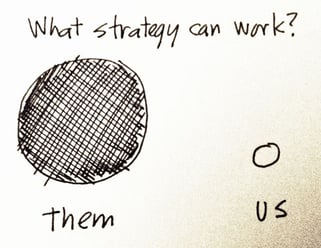Despite the talk about the importance of disruptive strategies, a more subtle, longevity strategy can also serve a brand well. This is especially true when you are a smaller player going up against competitors with superior resources. In these cases, developing a low-risk business model built to create your own game and designed for low-risk and longevity can work.
The Wall Street Journal Magazine, WSJ., published an article this weekend highlighting the strategic thinking behind a well-known example of a low-risk, longevity-oriented strategy. The magazine article featured Woody Allen and his film making strategy. While his personal decisions are reprehensible (as pointed out by many of the online comments), Woody Allen has successfully adopted a low-risk, longevity strategy in the film industry.
Strategic thinking for a Low-Risk and Longevity Strategy
 Given the talents, skills, and weaknesses he has, Allen either employed strategic thinking or found his way into a strategy that has enabled him to make forty-eight movies so far in his career. Allen's longevity is due in large part to a repeatable "operational" process and a strategy built on making movies that are so inexpensive that a movie studio cedes him control because they are comparatively low-risk compared to the typical movies made today.
Given the talents, skills, and weaknesses he has, Allen either employed strategic thinking or found his way into a strategy that has enabled him to make forty-eight movies so far in his career. Allen's longevity is due in large part to a repeatable "operational" process and a strategy built on making movies that are so inexpensive that a movie studio cedes him control because they are comparatively low-risk compared to the typical movies made today.
The article highlights at least seven strategic components of a longevity strategy that apply to others situations where a business does not want to or cannot easily play the same game as everyone else.
- Decide what matters to you then make everything else fit – even if it is different from the rest of the industry. (In this case, creative control matters to Woody Allen, so he makes inexpensive movies to be able to retain creative control.)
- Focus on solving what you can solve. (Woody Allen is able to get movies made so he makes movies instead of investing time on bigger, global questions.)
- Develop enough ideas so you can stay detached and move on from ideas that do not work - instead of increasing your risk position trying to make a unique idea work. (One collaborator describes Allen's willingness to walk away from a film project that does not gel and simply pursue another.)
- Adopt a style that fits your strategic approach and repeat it until it becomes your signature. (One example is Allen's tendency to use single, long shots in all his movies. He claims the long shots come from his personal laziness.)
- When pursuing a low-risk, longevity strategy that limits your upside and downside, consistency, frequency, and volume are vital to success. (Allen is constantly working on his next movie and regularly produces one movie annually.)
- Make sure you can secure disproportionately inexpensive resources to make your revenue and cost structure work. (Actors pursue the opportunity to work with Woody Allen and are eager to accept a role at union scale rates.)
- Build experimentation into what you do and get new and additional value from your key resources. (Allen purportedly gives actors little acting direction but encourages them to improvise and adapt dialogue in the script.)
Take or leave Woody Allen as a human being, but these strategic thinking lessons make sense for an underdog brand creating its own game inside the structure of someone else's game (Think about the Oakland A’s, as depicted in Moneyball, using quantitative and predictive analysis to make player personnel decisions and put a less expensive team on the field.)
There is more than one strategy for success, and a low-risk, longevity strategy can succeed with even inferior resources - even if it represents a different standard of success than big, traditional players employ. – Mike Brown
If you enjoyed this article, subscribe to the free Brainzooming email updates.
For More Information | Phone: 816-509-5320 | Email: info@brainzooming.com




